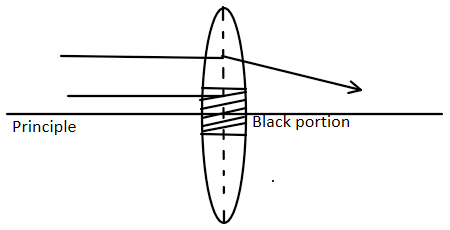
A convex lens of focal length $10cm$ is painted black at the middle portion as shown in figure. An object is placed at a distance of $20cm$from the lens. Then,
Answer
572.4k+ views
Hint: Given problem is based on the lens behaviour with the light rays. For solving such types of problems, we have the knowledge of the following points:
1) Construction of the lens.
2) Related terms (optical centre, focal length, etc.)
3) Rules associated with the path of light rays.
4) Refractive lens
Complete step-by-step solution:

We know the light ray passes through only transparent part of lens. The ray does not pass through black painted part of lens. Since the middle portion is black symmetrically, thus we have two transparent parts which are symmetrical about the principal axis. Each part (upper and lower) formed separate image of object, observe carefully these two images are coinciding. Therefore, we see only one image. Because optical axis of both the parts coincide. If the optical axis of both the parts were different, then two images would have formed separately. But in given problem only one image obtained by symmetry.
Note:- Lens construction and theory associated with the geometrical part of maths. Image formed by the lens depends on the shape of the face and refractive index of the material. We should revise the formation of images corresponding to different positions of objects.
1) Construction of the lens.
2) Related terms (optical centre, focal length, etc.)
3) Rules associated with the path of light rays.
4) Refractive lens
Complete step-by-step solution:

We know the light ray passes through only transparent part of lens. The ray does not pass through black painted part of lens. Since the middle portion is black symmetrically, thus we have two transparent parts which are symmetrical about the principal axis. Each part (upper and lower) formed separate image of object, observe carefully these two images are coinciding. Therefore, we see only one image. Because optical axis of both the parts coincide. If the optical axis of both the parts were different, then two images would have formed separately. But in given problem only one image obtained by symmetry.
Note:- Lens construction and theory associated with the geometrical part of maths. Image formed by the lens depends on the shape of the face and refractive index of the material. We should revise the formation of images corresponding to different positions of objects.
Recently Updated Pages
Master Class 12 Business Studies: Engaging Questions & Answers for Success

Master Class 12 Economics: Engaging Questions & Answers for Success

Master Class 12 English: Engaging Questions & Answers for Success

Master Class 12 Maths: Engaging Questions & Answers for Success

Master Class 12 Social Science: Engaging Questions & Answers for Success

Master Class 12 Chemistry: Engaging Questions & Answers for Success

Trending doubts
What are the major means of transport Explain each class 12 social science CBSE

Which are the Top 10 Largest Countries of the World?

Draw a labelled sketch of the human eye class 12 physics CBSE

Explain sex determination in humans with line diag class 12 biology CBSE

The pH of the pancreatic juice is A 64 B 86 C 120 D class 12 biology CBSE

Explain sex determination in humans with the help of class 12 biology CBSE




